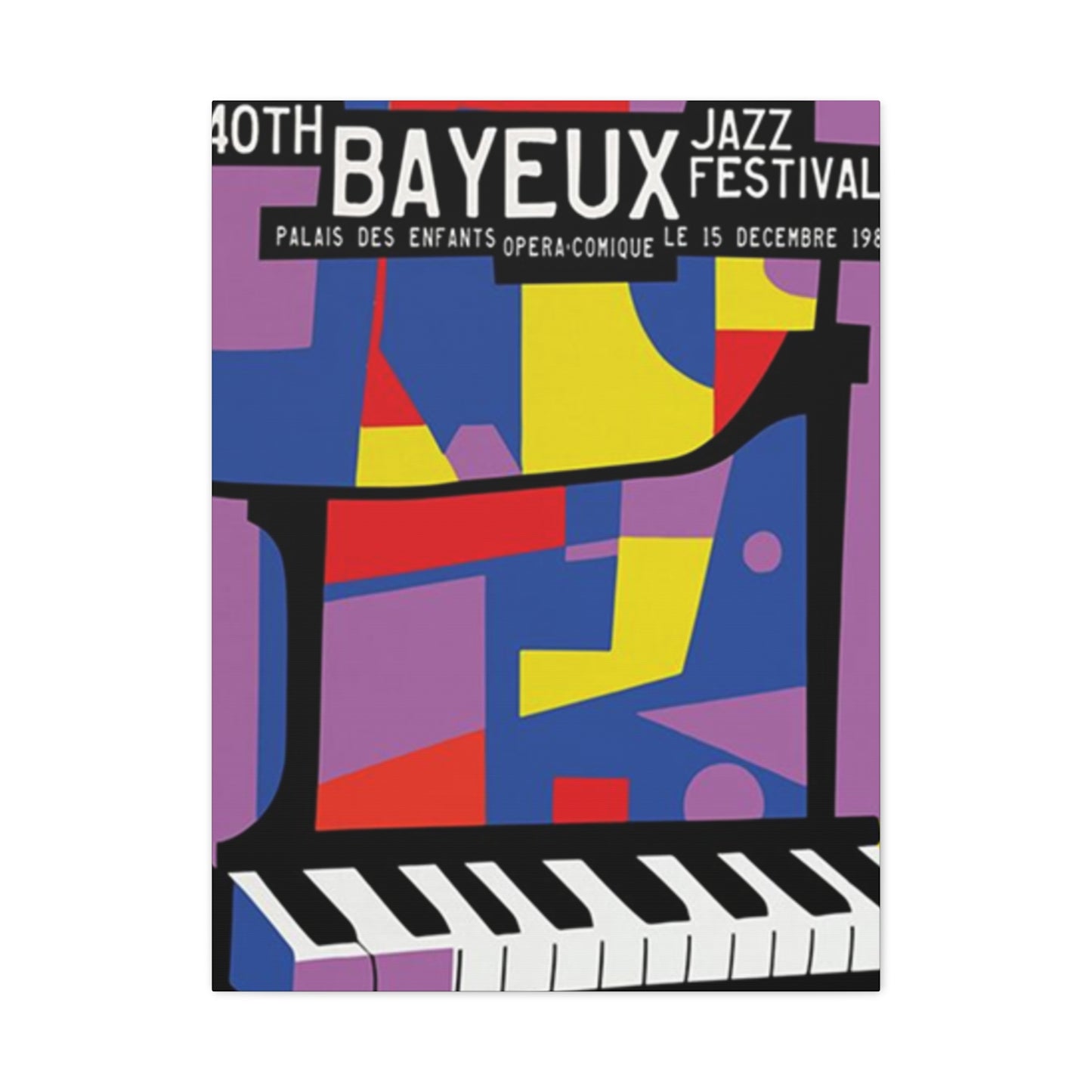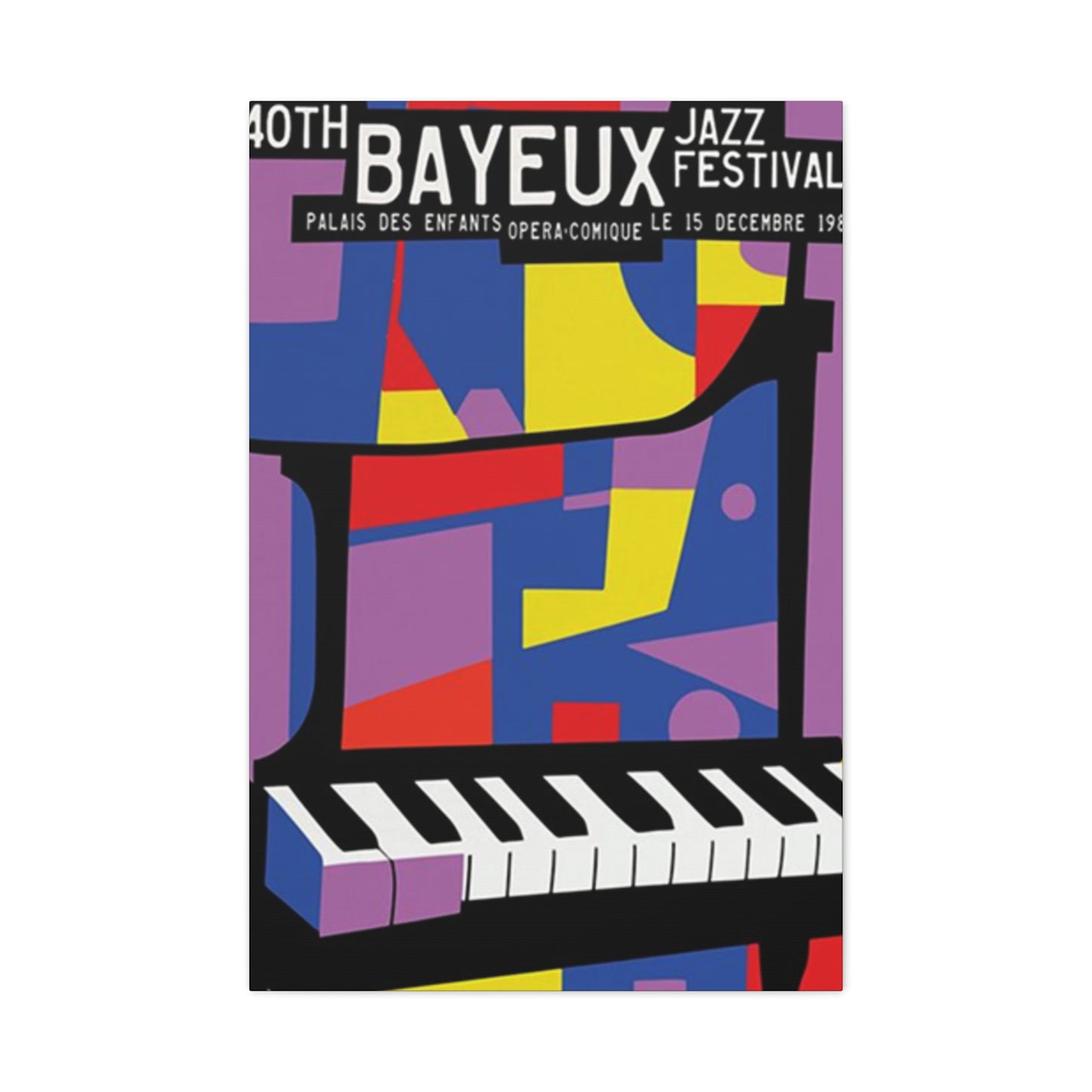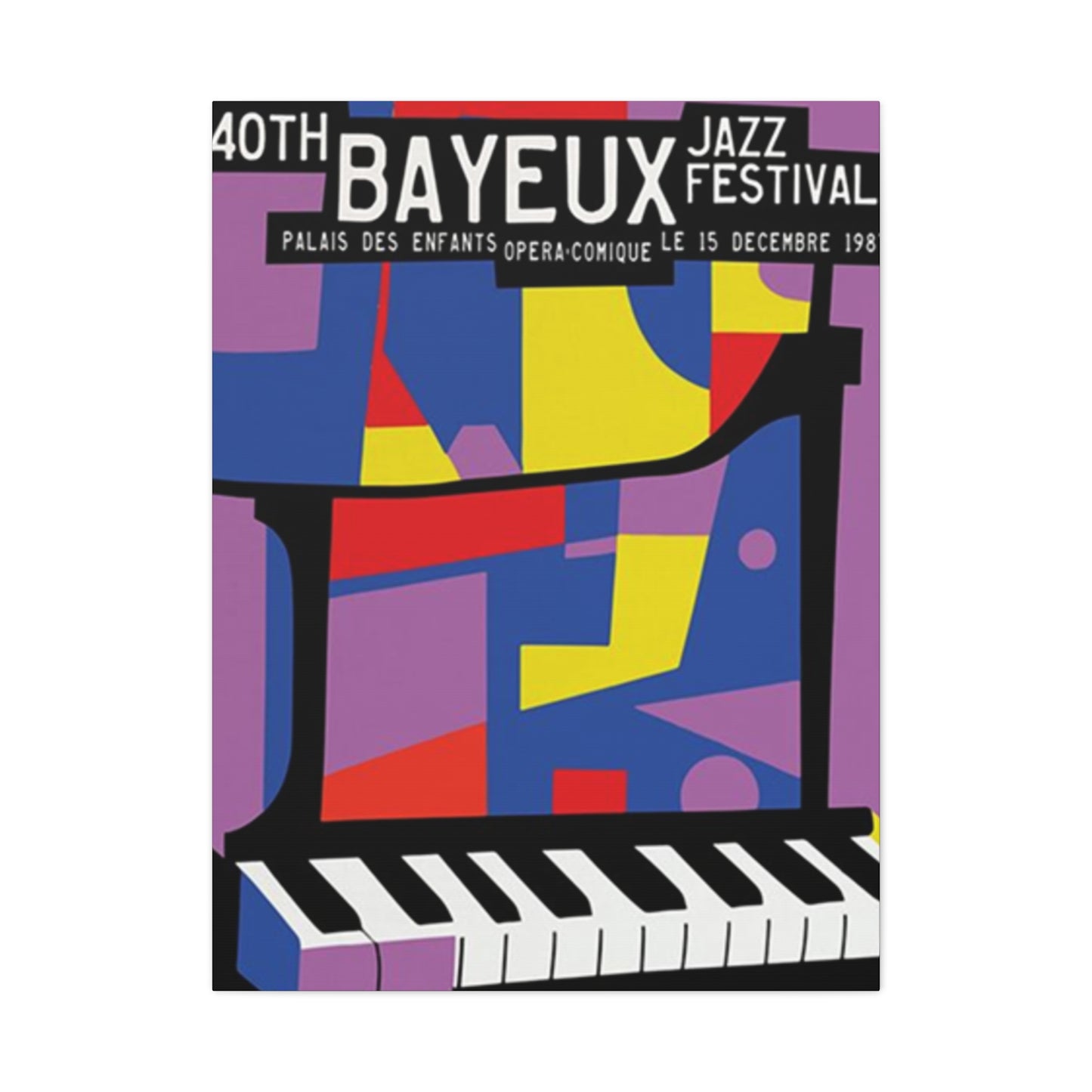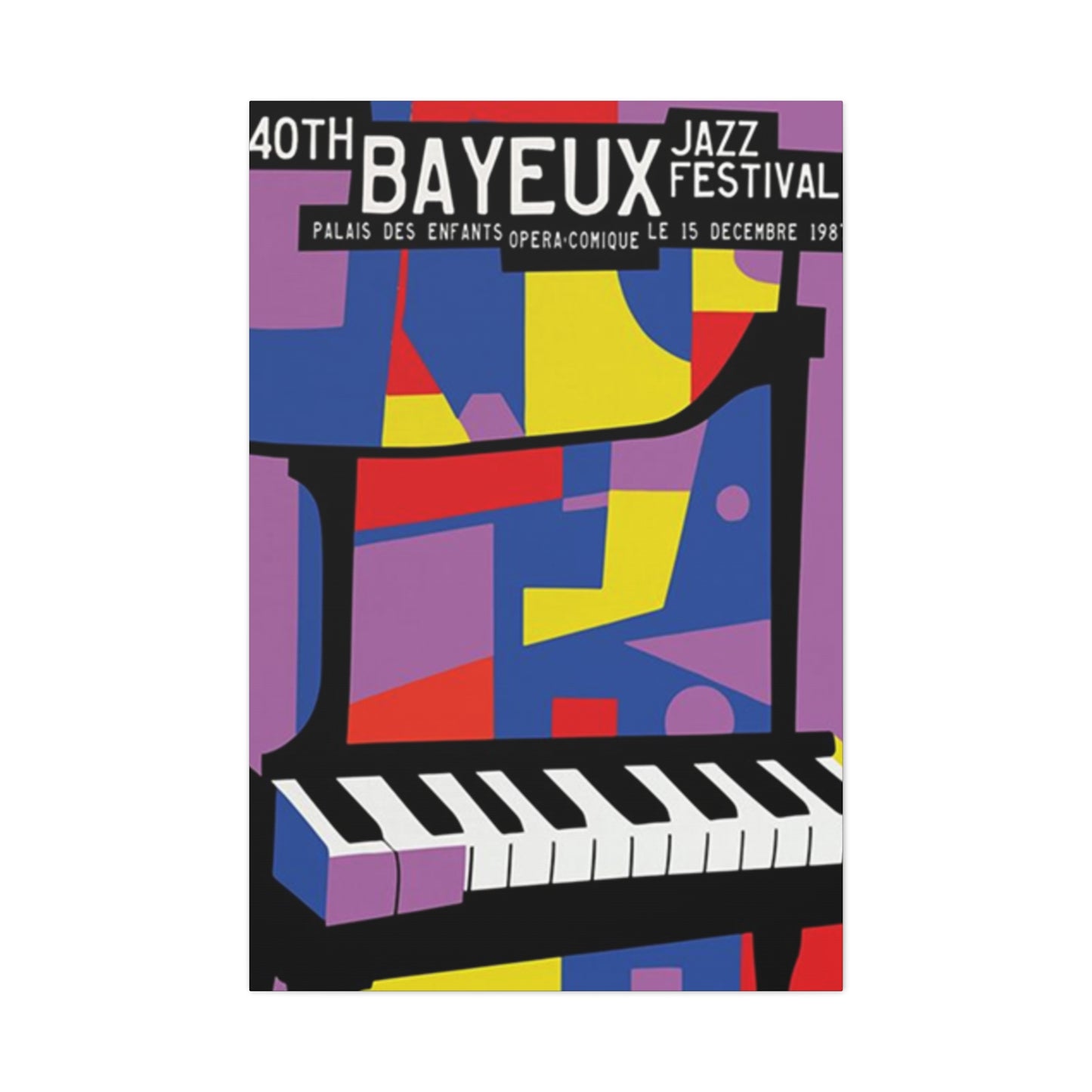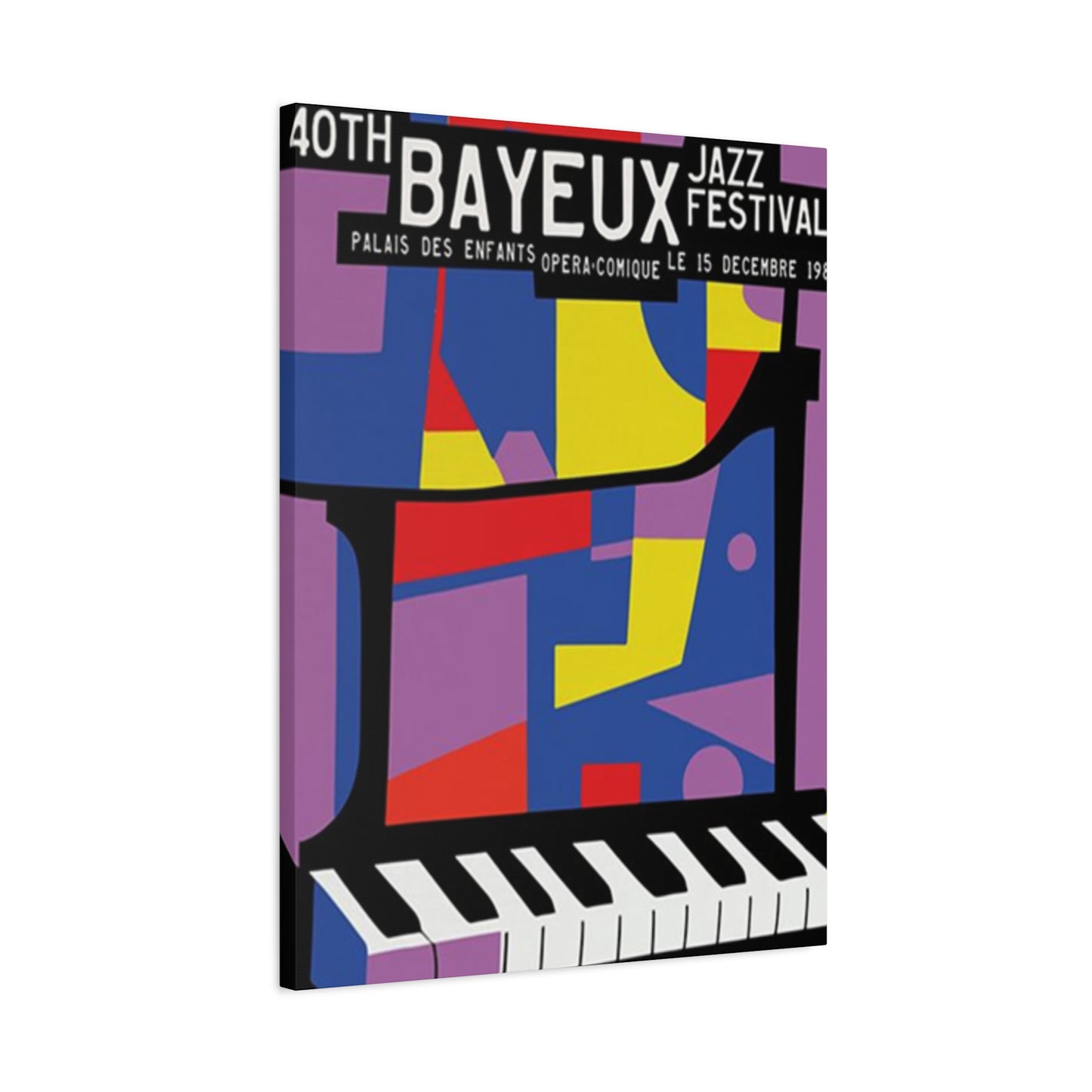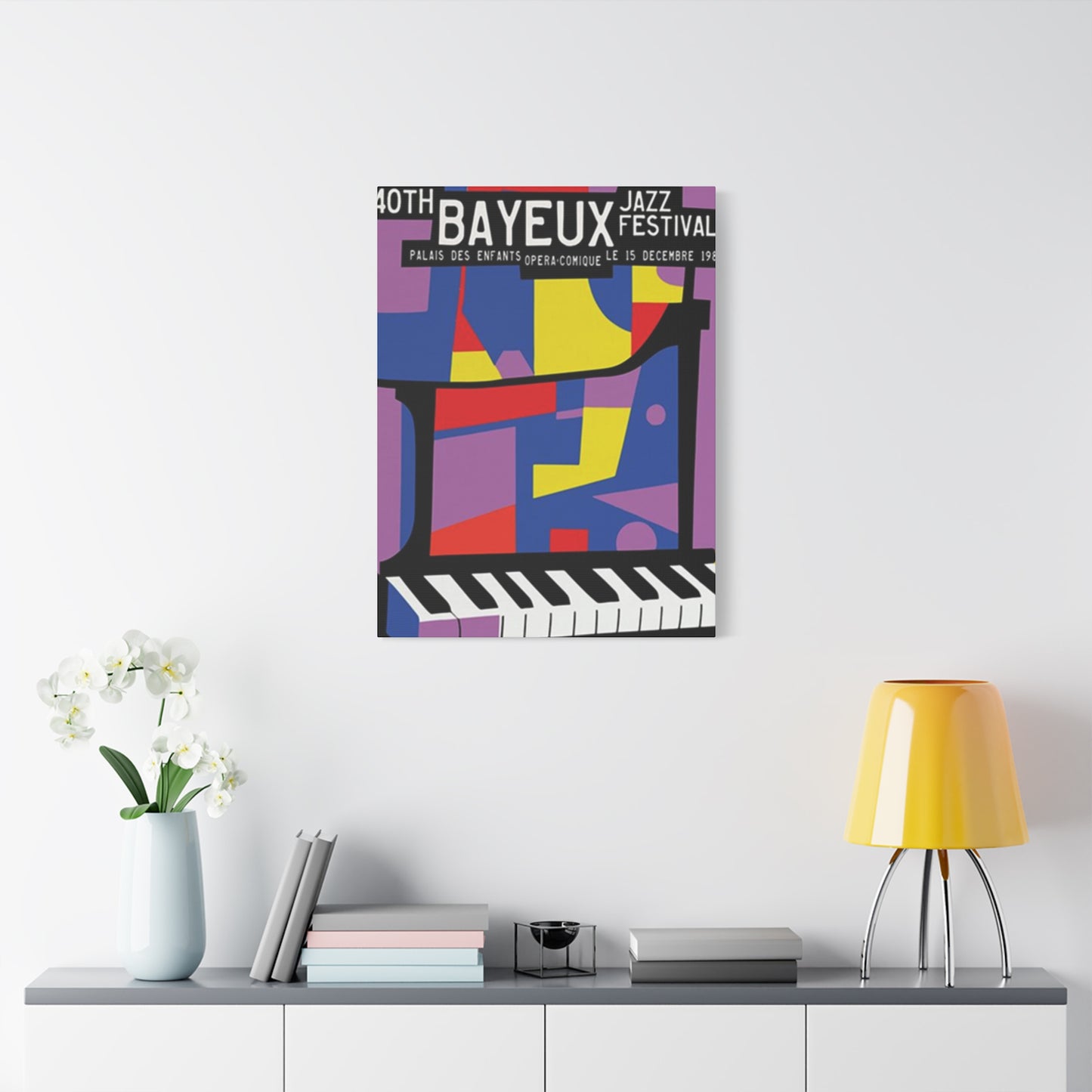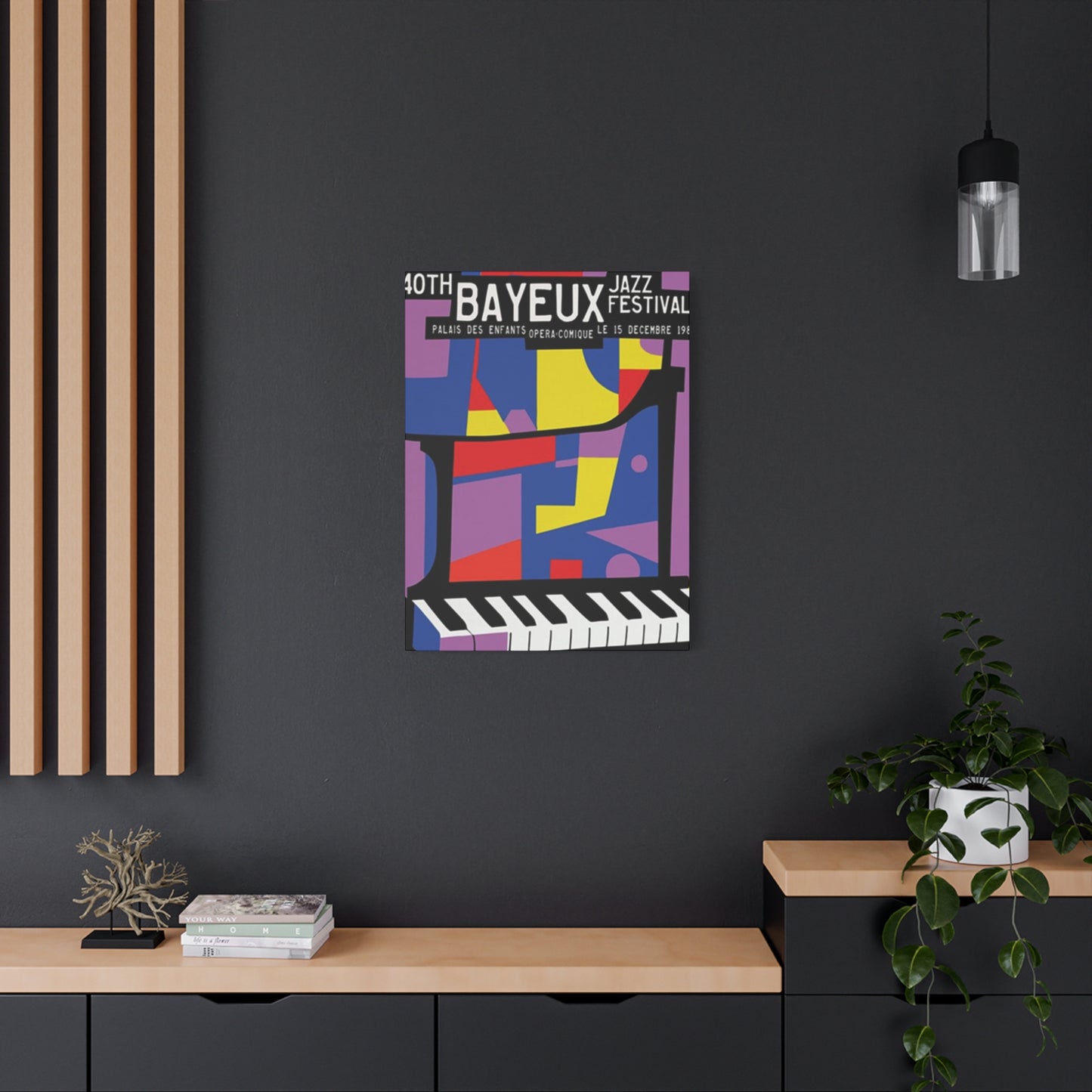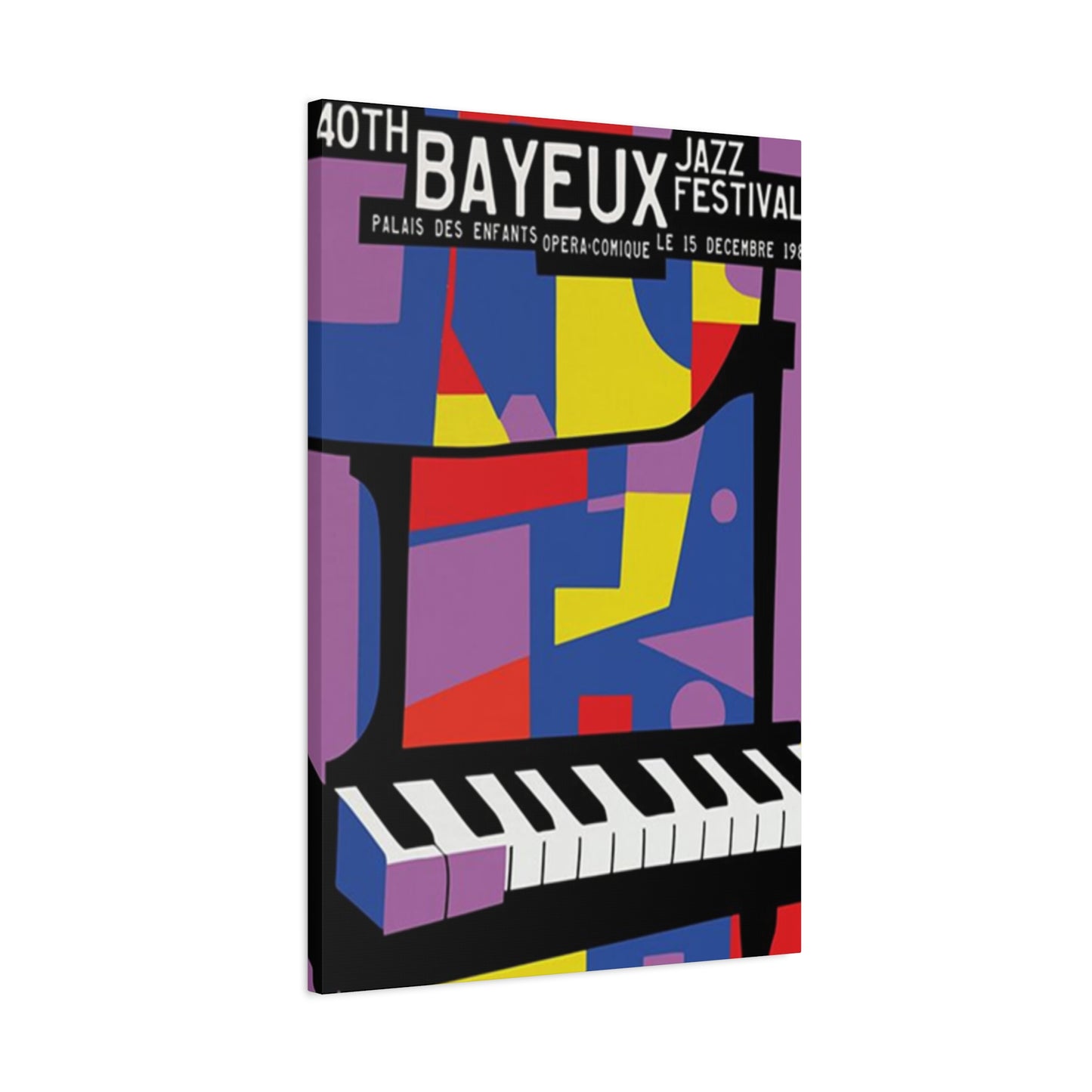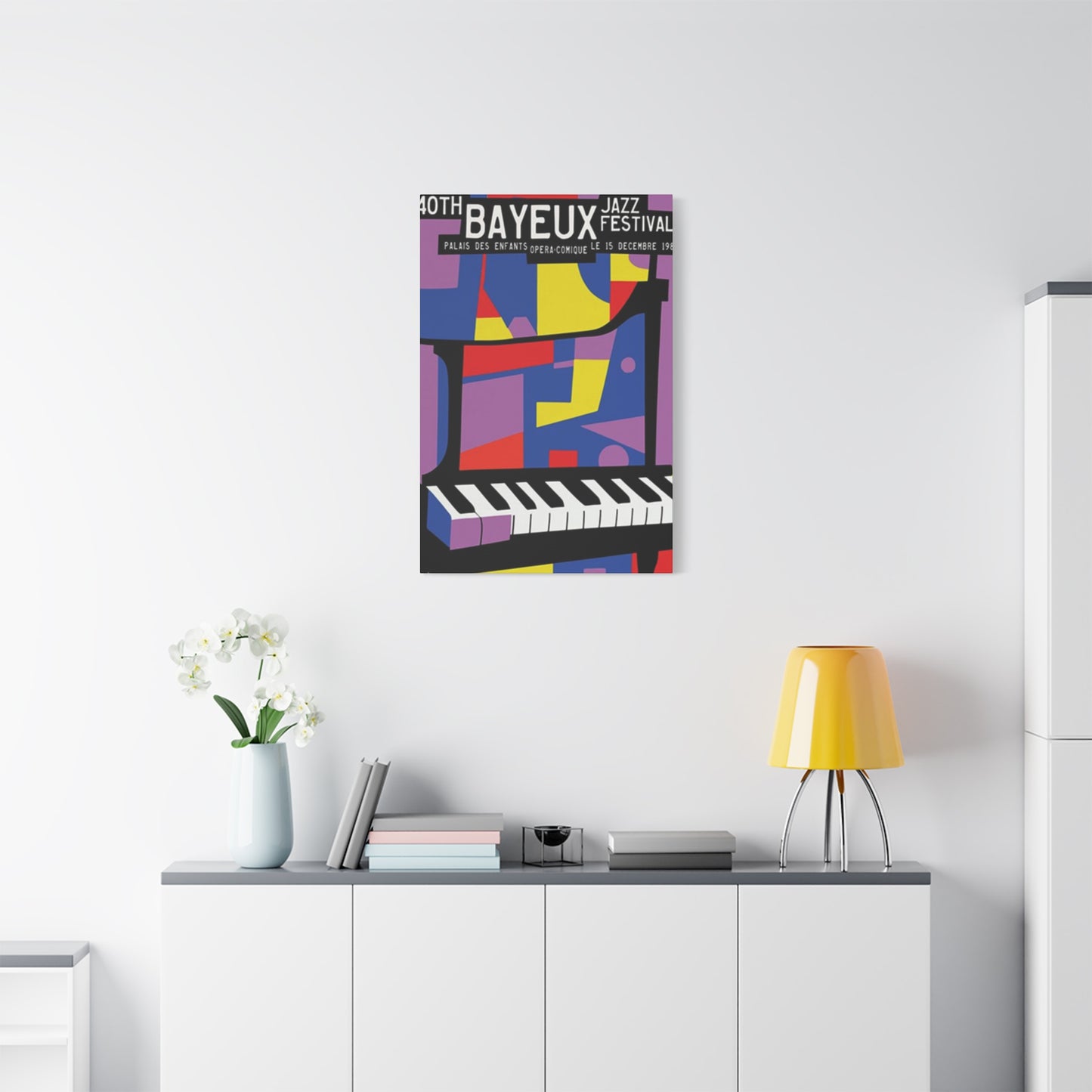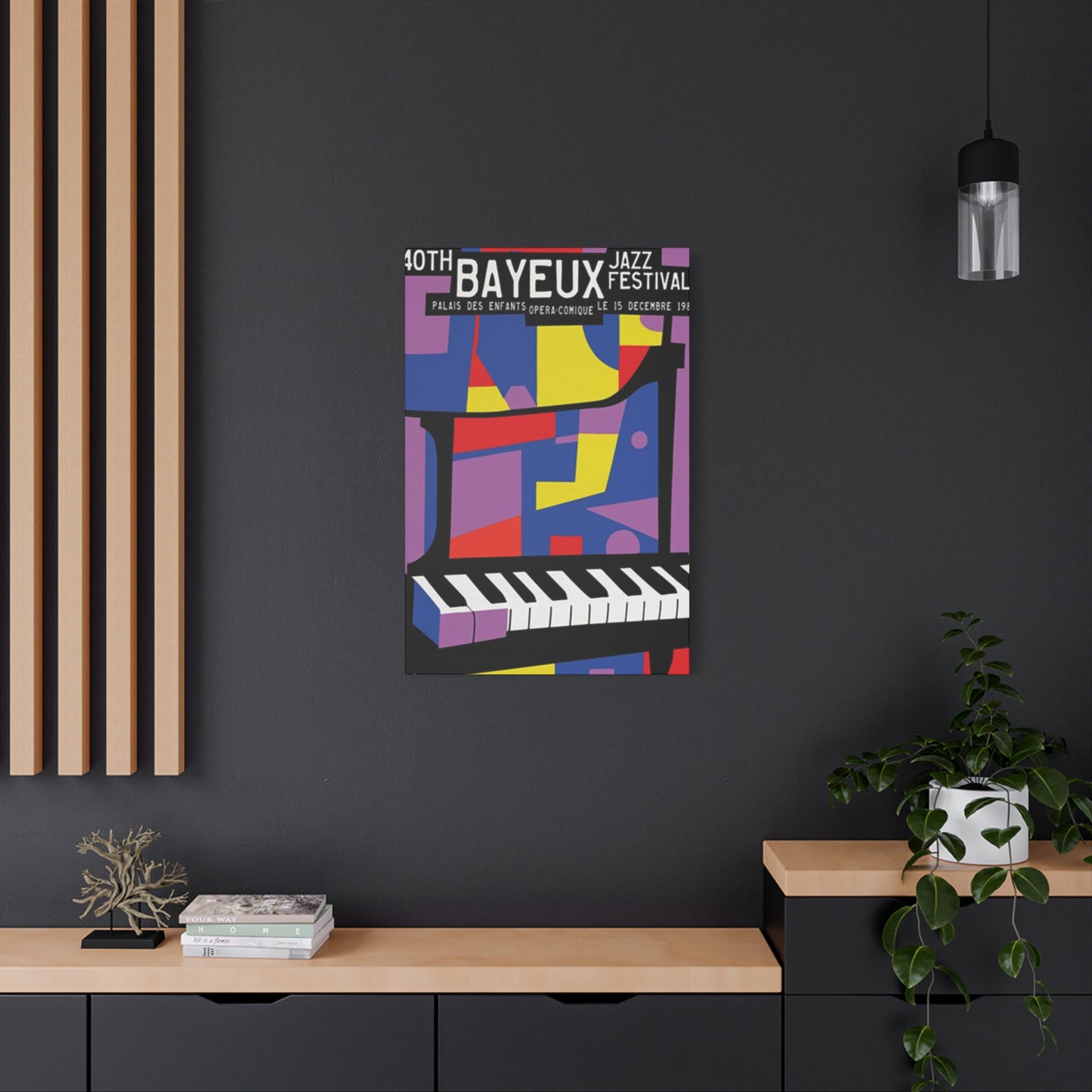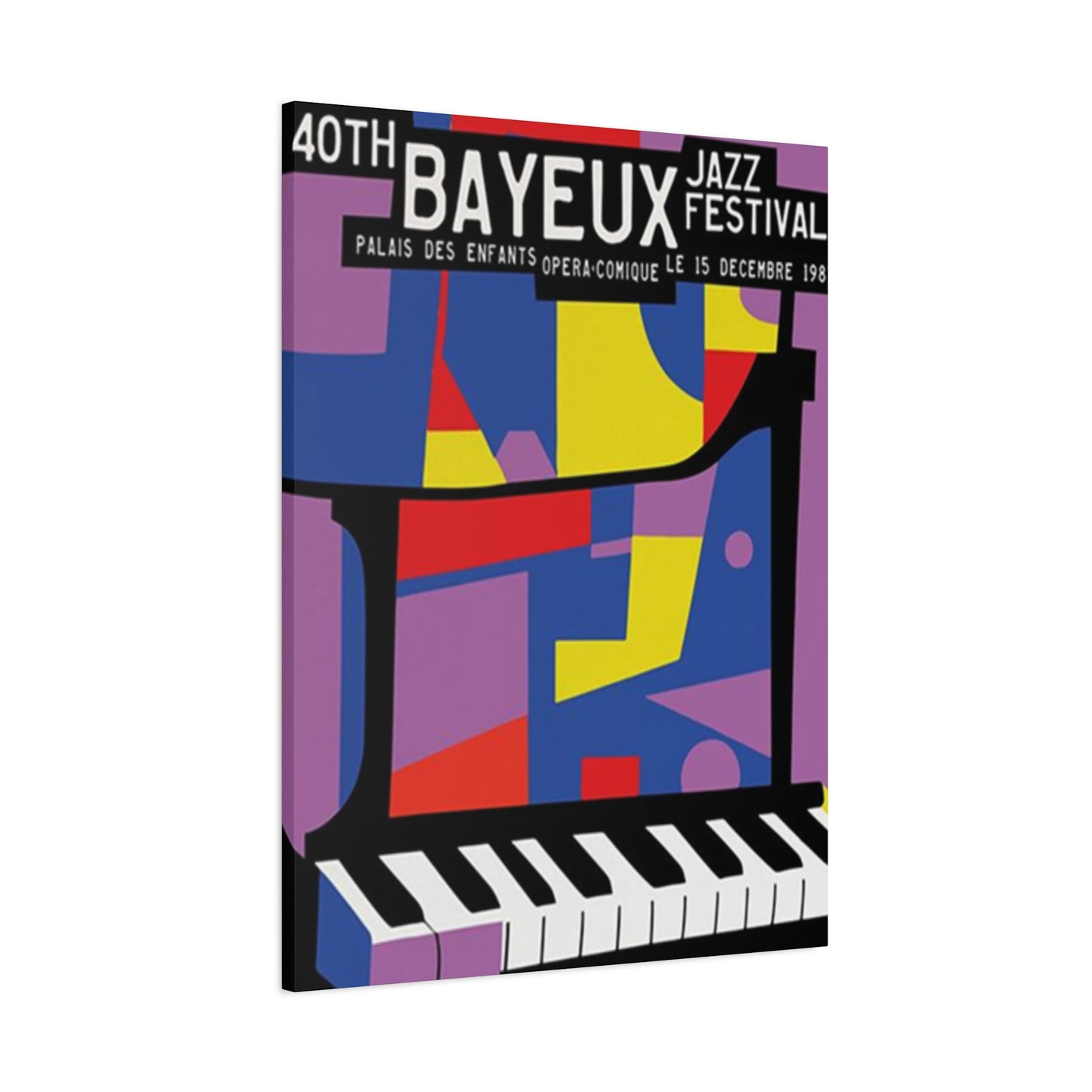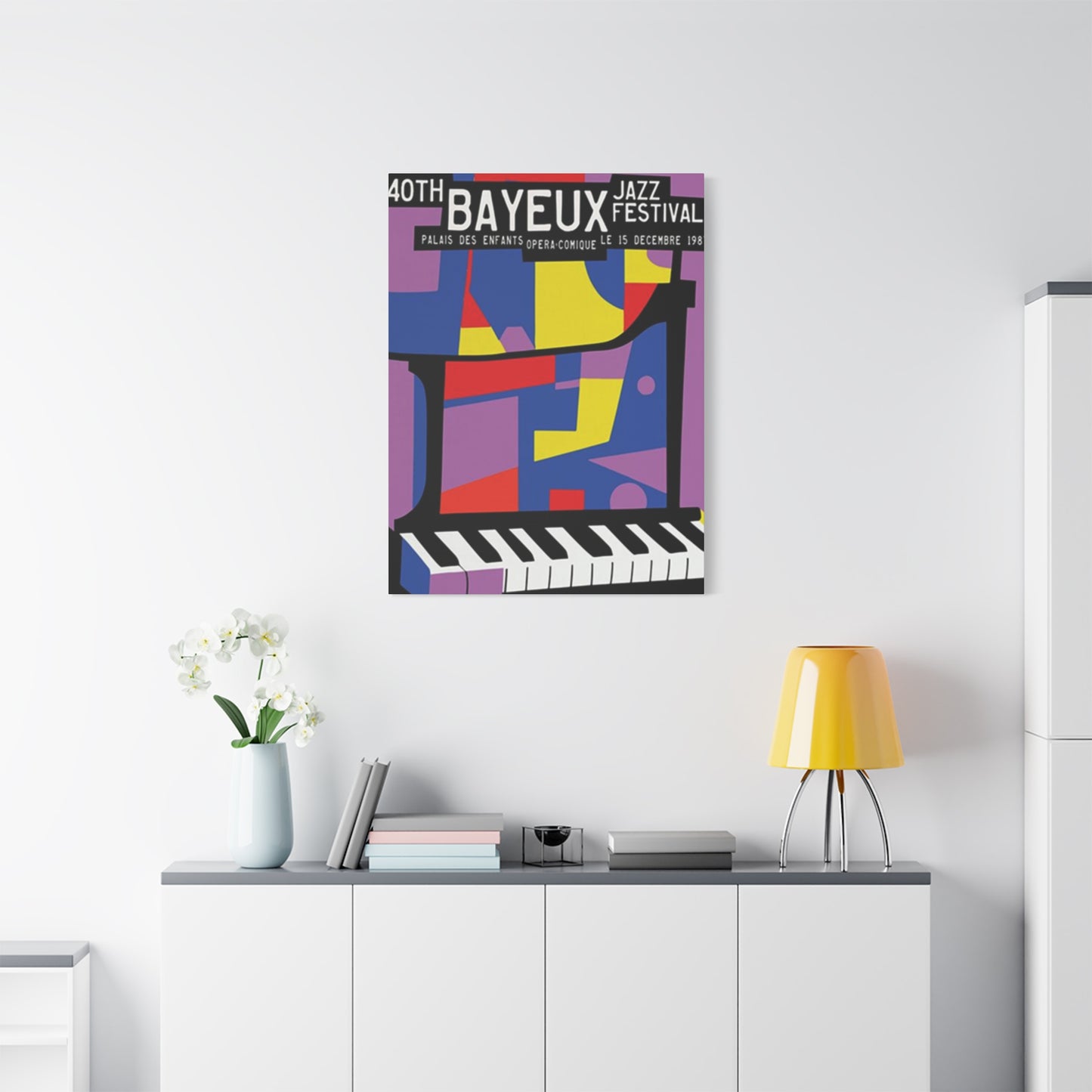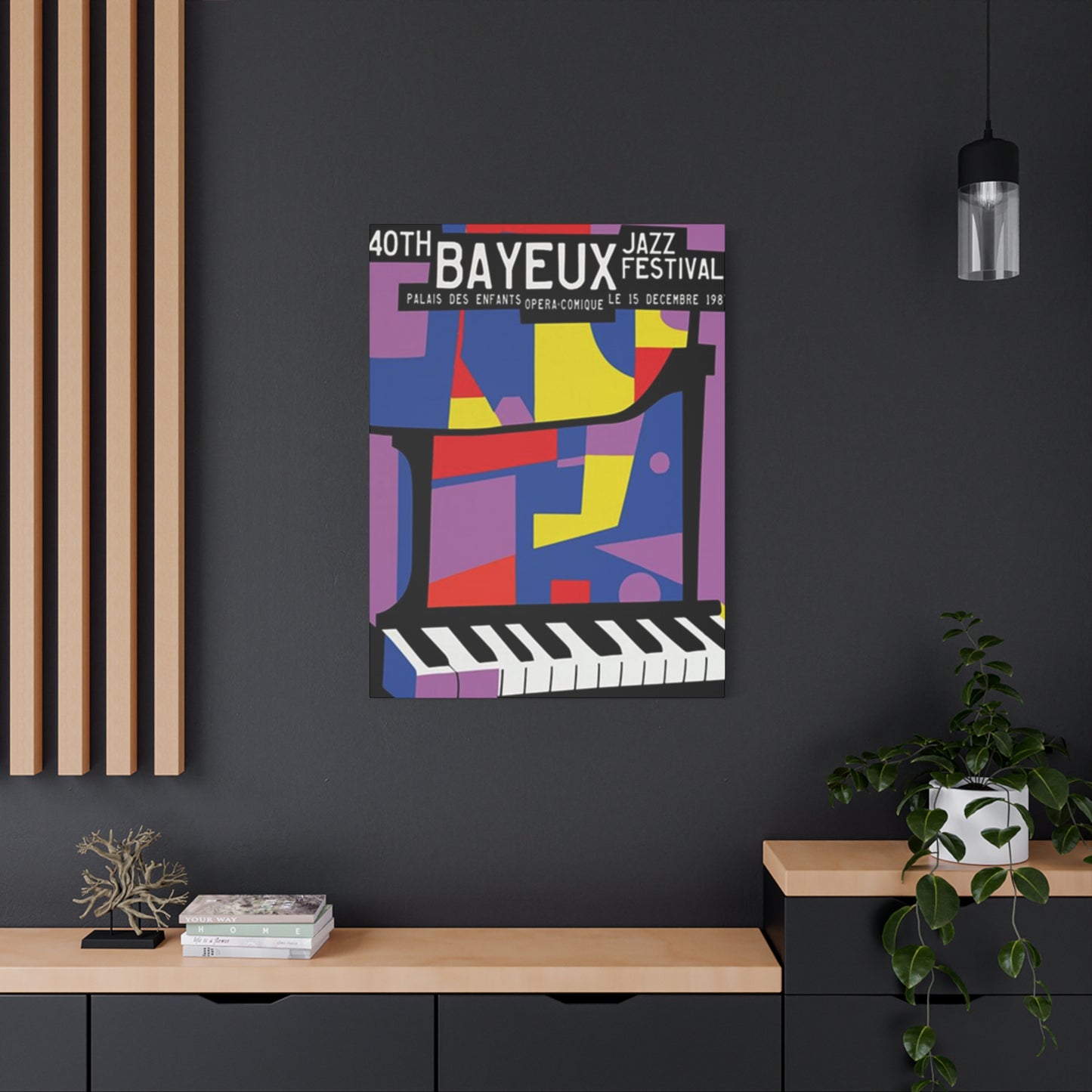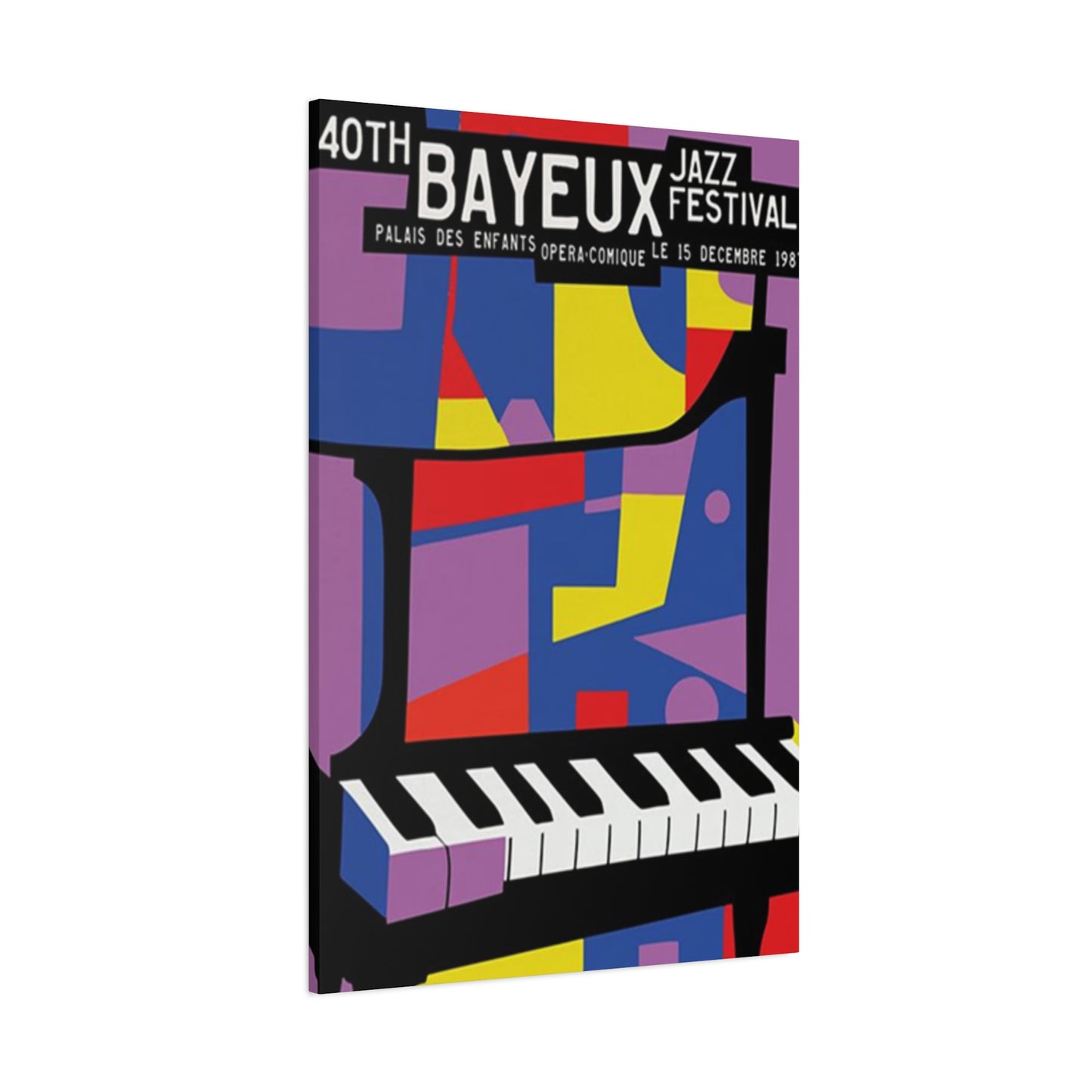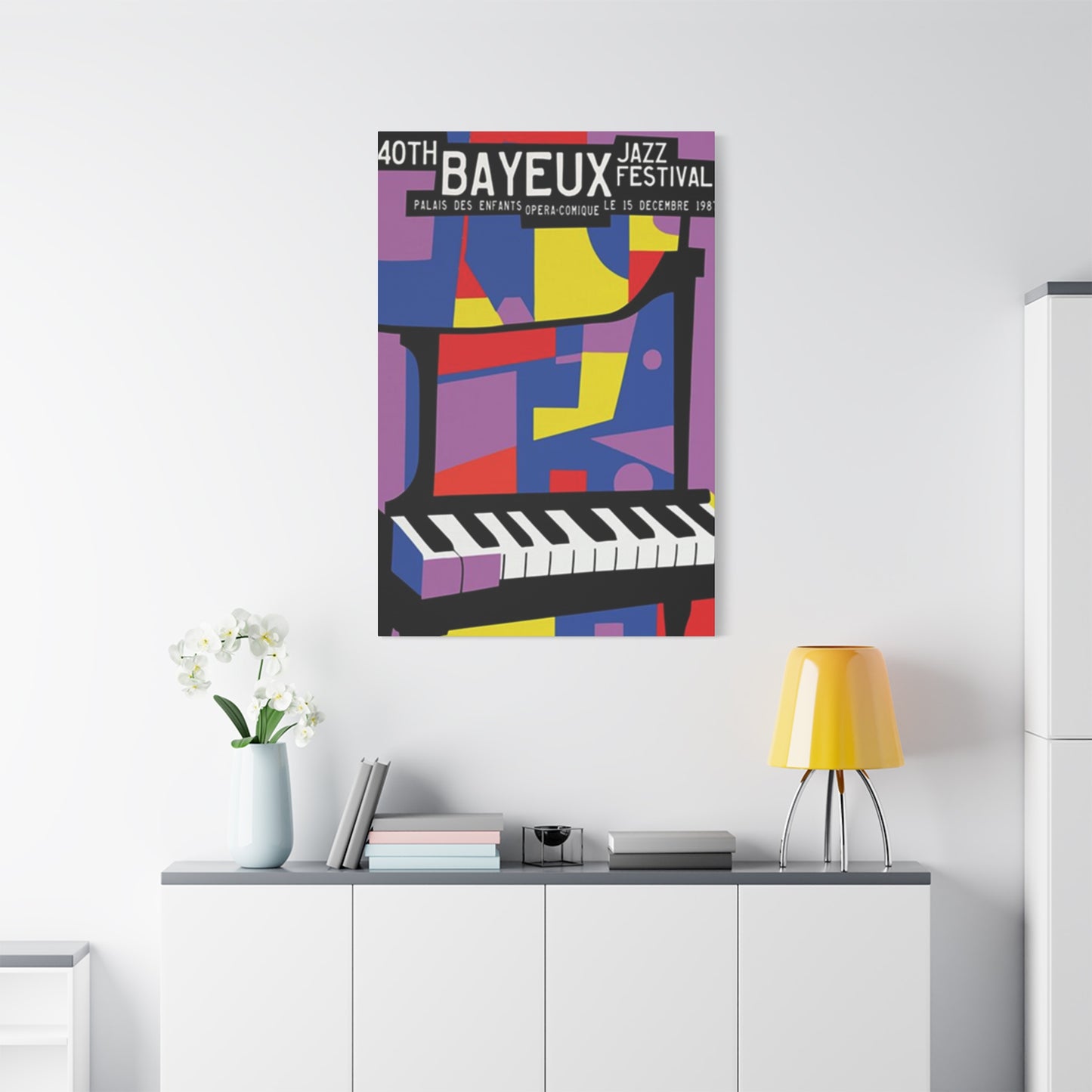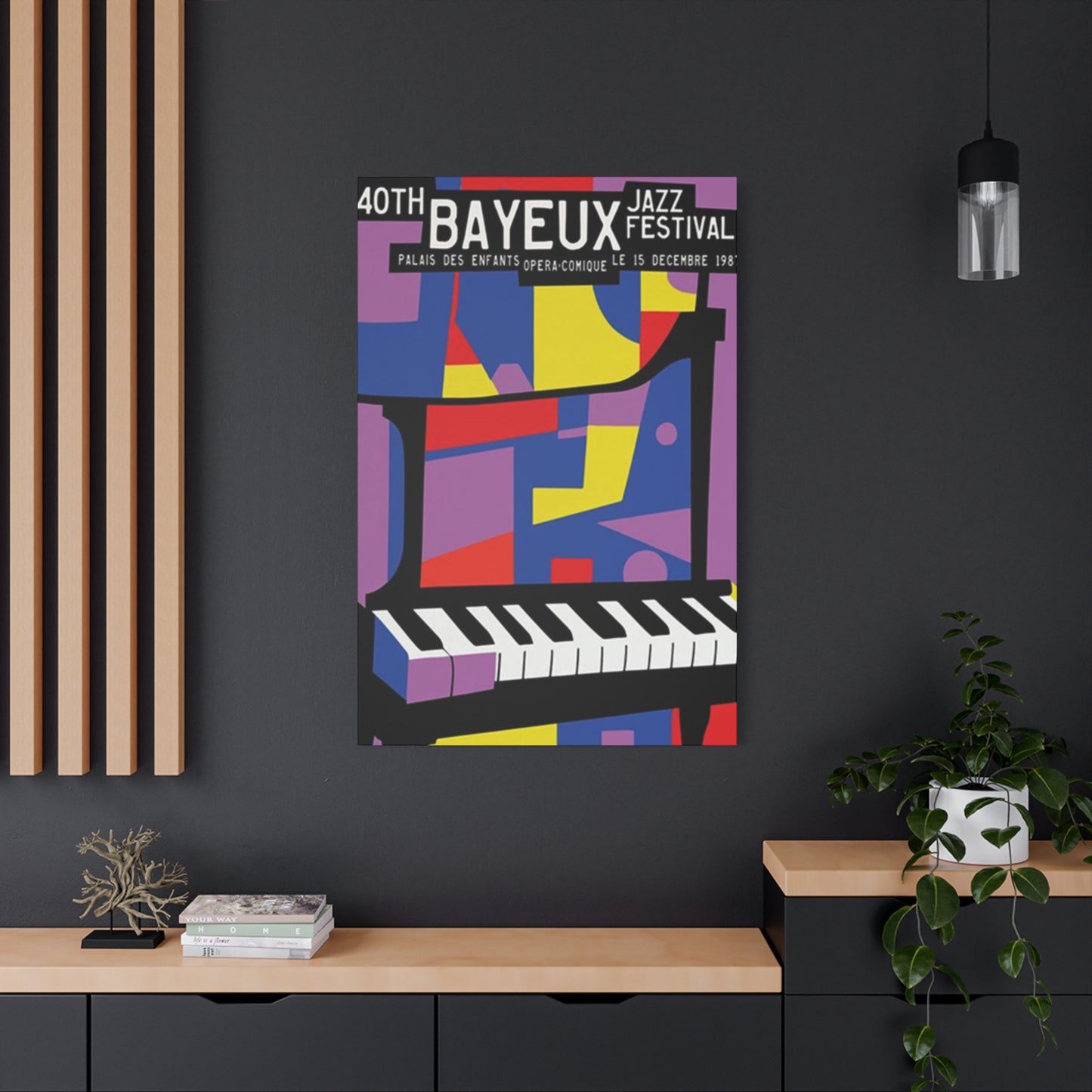Bayeux Jazz Festival Wall Art: A Comprehensive Guide to Musical Visual Expression
The Bayeux Jazz Festival has established itself as one of France's most celebrated musical events, creating not only unforgettable sonic experiences but also remarkable visual legacies through its distinctive wall art and poster designs. This annual celebration brings together musicians, artists, and enthusiasts from around the world, generating a unique cultural phenomenon that extends far beyond the concert stages. The festival's commitment to artistic excellence manifests through carefully crafted visual representations that capture the essence of jazz music while reflecting the rich cultural heritage of the Normandy region.
Throughout its four-decade history, the festival has commissioned talented artists to create stunning visual representations that serve multiple purposes: promotional materials, collectible memorabilia, and lasting artistic statements. These creations have evolved from simple promotional tools into sophisticated works of art that stand alone as compelling visual expressions of musical culture. The wall art associated with this festival represents a fascinating intersection of musical passion and visual creativity, offering insights into how different artistic mediums can complement and enhance each other.
The significance of these visual works extends beyond their immediate promotional function, as they contribute to the broader cultural landscape of jazz appreciation and artistic expression. Festival organizers have consistently recognized the importance of high-quality visual representation, understanding that compelling artwork can attract new audiences while providing existing fans with meaningful ways to connect with the festival experience long after the final note has been played.
Symbolic Elements in Bayeux Jazz Festival Poster Designs and Wall Art
The visual language employed in Bayeux Jazz Festival promotional materials demonstrates a sophisticated understanding of symbolic communication, utilizing recurring motifs that resonate with both jazz enthusiasts and general audiences. Musical instruments frequently serve as central focal points, with saxophones, trumpets, and piano keys appearing in stylized forms that capture the dynamic energy of live performance. These instruments are often rendered in abstract or impressionistic styles, suggesting movement and sound through visual means.
Color palettes typically draw inspiration from the emotional spectrum of jazz music itself, incorporating deep blues that evoke the melancholic aspects of the genre, vibrant golds and yellows that suggest the brightness of brass instruments, and rich purples that capture the sophisticated atmosphere of evening performances. The careful selection and application of these colors creates visual harmony that mirrors the musical harmonies central to jazz composition.
Typography plays a crucial role in these designs, with letterforms often reflecting the improvisational nature of jazz music through flowing, organic shapes or bold, confident strokes that mirror the assertiveness of jazz performance. The integration of text and imagery demonstrates sophisticated design principles, ensuring that practical information remains clearly readable while contributing to the overall artistic impact of the piece.
Geometric patterns and abstract forms frequently appear in these works, creating visual rhythms that parallel the complex time signatures and syncopated rhythms characteristic of jazz music. These elements help viewers understand the connection between visual and auditory art forms, demonstrating how different creative mediums can share fundamental structural principles.
French Artistic Traditions Influencing Bayeux Jazz Festival Designs
The visual aesthetics of Bayeux Jazz Festival artwork reflect deep connections to France's rich artistic heritage, drawing inspiration from various movements that have shaped the country's cultural identity. Elements of Art Nouveau can be observed in the flowing, organic lines that often characterize poster designs, while influences from Post-Impressionism appear in the bold use of color and emphasis on emotional expression over literal representation.
The legacy of French poster art, particularly the work of artists like Henri de Toulouse-Lautrec and Jules Chéret, provides a historical foundation for contemporary festival artwork. These early pioneers of poster design established principles of visual communication that continue to influence modern promotional art, including the effective use of limited color palettes, clear hierarchical organization of information, and the integration of text and imagery into cohesive compositions.
Contemporary French graphic design sensibilities contribute to the sophisticated aesthetic choices evident in festival materials. The emphasis on conceptual clarity, refined execution, and cultural relevance reflects broader trends in French visual culture, where artistic expression is valued not only for its immediate appeal but also for its contribution to ongoing cultural dialogue.
Regional artistic traditions specific to Normandy also influence these designs, with subtle references to local architectural elements, natural landscapes, and historical themes that connect the festival to its geographic and cultural context. This approach helps establish the event as an authentic expression of local culture while maintaining its appeal to international audiences.
Professional Presentation Techniques for Bayeux Jazz Festival Wall Art
The proper presentation of festival artwork requires careful attention to framing techniques that enhance rather than distract from the visual impact of the original design. Professional-grade materials ensure longevity and protect the artwork from environmental factors that could cause deterioration over time. Archival-quality matting prevents acid damage while creating appropriate visual breathing room around the central image.
Frame selection should complement the artistic style of the piece without overwhelming its visual presence. Simple, clean lines work well with contemporary designs, while more ornate frames may be appropriate for works that incorporate classical or vintage aesthetic elements. The color and finish of the frame should harmonize with the artwork's palette while remaining subtle enough to avoid visual competition.
Lighting considerations play a crucial role in proper presentation, with museum-quality LED lighting providing optimal illumination without generating harmful heat or ultraviolet radiation. Proper placement ensures even illumination across the entire surface while minimizing glare that could interfere with viewing. Professional installation techniques ensure secure mounting while protecting both the artwork and the wall surface.
Conservation considerations become particularly important for limited edition or vintage festival posters, requiring specialized handling and presentation techniques that preserve the integrity of the original materials. Professional conservators can provide guidance on appropriate preservation methods for valuable or historically significant pieces.
Acoustic Enhancement Through Visual Art in Music Studios
The integration of jazz festival artwork into recording and rehearsal environments creates synergistic effects that benefit both the visual and auditory experiences within these creative locations. Carefully selected and positioned artwork can contribute to the acoustic properties of a room while providing visual inspiration that enhances the creative process for musicians and producers.
The psychological impact of appropriate visual stimulation in music-making environments has been well-documented, with studies showing that inspiring artwork can increase creative output and improve the quality of musical performance. Jazz festival posters and related artwork provide particularly relevant inspiration for musicians working within this genre, offering visual reminders of the rich tradition and ongoing vitality of jazz culture.
Color choices in studio artwork can influence mood and energy levels, with warm colors promoting active creativity and cooler tones supporting focused concentration during detailed work. The dynamic visual elements typical of jazz festival art can help maintain creative momentum during long recording sessions while providing welcome visual relief from technical equipment and control surfaces.
Strategic placement of artwork ensures maximum visual impact without interfering with acoustic treatments or equipment access. Professional acousticians can advise on positioning that maximizes both visual appeal and acoustic function, ensuring that artwork placement supports rather than compromises the technical requirements of the recording environment.
Commemorative Significance of the 40th Edition Artwork
The fortieth anniversary of the Bayeux Jazz Festival represented a major milestone that called for special artistic recognition, resulting in commemorative artwork that captured both the festival's historical significance and its ongoing cultural relevance. These special edition pieces incorporated visual elements that referenced key moments in the festival's history while looking forward to future developments and growth.
Anniversary artwork often employs temporal design strategies that suggest the passage of time through visual metaphors such as flowing ribbons, spiral forms, or layered compositions that reveal historical depth. The challenge for artists creating commemorative works lies in balancing nostalgia with forward-looking optimism, creating pieces that honor the past while expressing excitement about future possibilities.
Limited production runs of anniversary artwork increase their collectible value while ensuring that these special pieces remain exclusive commemoratives rather than standard promotional materials. The scarcity of these items contributes to their desirability among collectors while providing the festival with distinctive merchandise that generates both revenue and promotional value.
Documentation of the creative process behind anniversary artwork provides valuable insights into how artists approach commemorative projects, revealing the research, conceptual development, and technical execution required to create works that successfully capture the significance of major milestones.
Harmonious Integration of Festival Art with Vintage Music Memorabilia
The combination of contemporary jazz festival artwork with vintage music memorabilia creates rich, layered displays that tell compelling stories about the evolution of musical culture. This approach to collection and display demonstrates how different eras of musical history can inform and enhance each other, creating visual narratives that span decades of artistic development.
Vintage instruments, concert programs, photographs, and recordings provide historical context that enriches the appreciation of contemporary festival art. The juxtaposition of old and new creates visual tension that keeps viewers engaged while highlighting the continuity of jazz tradition across different time periods. This approach works particularly well in private collections, music venues, and educational environments.
Color coordination between vintage pieces and contemporary artwork requires careful attention to ensure visual harmony while maintaining the distinct character of each element. Professional display designers often employ neutral background colors and consistent lighting to unify disparate elements while allowing each piece to maintain its individual identity.
Storage and preservation considerations become more complex when combining materials from different eras, as various types of artifacts may have different environmental requirements and preservation needs. Professional conservation advice helps ensure that all elements of a mixed collection receive appropriate care and protection.
Cultural Impact of Jazz Festival Art on Local Communities
The visual legacy of the Bayeux Jazz Festival extends far beyond the duration of the annual event, creating lasting cultural impact that enriches the local community throughout the year. Public displays of festival artwork in restaurants, shops, and community centers help maintain awareness of the event while contributing to the overall cultural atmosphere of the region.
Local artists often find inspiration and opportunities through their involvement with festival artwork, whether as creators of original pieces or as participants in related workshops and educational programs. This involvement helps develop local artistic talent while ensuring that festival visuals reflect authentic regional perspectives and sensibilities.
Economic benefits flow from the increased cultural profile that results from high-quality festival artwork, as visitors drawn to the region for the festival often return throughout the year, attracted by the ongoing cultural richness that the festival helps to promote. Local businesses benefit from this increased cultural tourism, creating sustainable economic impact that extends the festival's value to the broader community.
Educational institutions often incorporate festival artwork into curriculum materials, using these visual resources to teach students about graphic design, cultural expression, and the relationship between different artistic mediums. This educational application helps ensure that the cultural impact of the festival continues to influence future generations.
Featured Artists and Their Contributions to Festival Visual Identity
The artists responsible for creating Bayeux Jazz Festival artwork represent diverse backgrounds and artistic approaches, each contributing unique perspectives that enrich the festival's visual legacy. These creative professionals work within the constraints of promotional requirements while expressing personal artistic visions that resonate with festival audiences.
Many featured artists have backgrounds that combine formal art education with practical experience in commercial design, bringing both technical skill and creative vision to their festival commissions. This combination of abilities enables them to create works that function effectively as promotional materials while standing alone as compelling artistic statements.
The selection process for festival artists typically involves careful consideration of both artistic merit and cultural fit, ensuring that chosen creators can effectively communicate the festival's values and atmosphere through their work. This process often involves reviewing portfolios, conducting interviews, and sometimes commissioning preliminary sketches or concepts before finalizing artist selection.
Long-term relationships between the festival and particular artists can result in visual consistency that helps establish strong brand recognition while allowing for creative evolution that keeps the festival's visual identity fresh and engaging. These ongoing collaborations benefit both parties, providing artists with regular creative challenges while giving the festival access to deepening artistic relationships.
Jazz Festival Wall Art as Thoughtful Musical Gifts
Festival artwork makes exceptional gifts for music enthusiasts, providing lasting reminders of shared musical experiences while supporting the artists and organizations that create these cultural events. The personal nature of music appreciation means that carefully chosen festival artwork can serve as deeply meaningful presents that reflect understanding of the recipient's interests and passions.
Gift selection requires consideration of the recipient's aesthetic preferences, living situation, and relationship to jazz music. Original posters from festivals the recipient has attended carry special emotional significance, while artwork from prestigious festivals they have not yet experienced can inspire future travel and cultural exploration.
Presentation considerations for gift artwork include professional framing, protective packaging, and accompanying information about the artist, festival, and historical context. These additional elements demonstrate thoughtfulness while providing educational value that enhances the recipient's appreciation of the gift.
The collectible nature of festival artwork means that gifts of this type often appreciate in value over time, providing recipients with items that serve as both personal enjoyment and potential investment pieces. This dual nature makes festival artwork particularly appropriate for significant gift-giving occasions such as graduations, retirements, or major anniversaries.
Historical Development of Poster Art at the Bayeux Jazz Festival
The evolution of visual design at the Bayeux Jazz Festival reflects broader changes in graphic design technology, artistic trends, and cultural values over the festival's four-decade history. Early poster designs often employed traditional illustration techniques and limited color palettes constrained by printing technology available at the time.
The introduction of digital design tools transformed the possibilities for festival artwork, enabling more complex color gradations, precise typography, and sophisticated image manipulation that would have been difficult or impossible to achieve using traditional methods. This technological evolution allowed artists to explore new creative directions while maintaining the high production standards expected for professional promotional materials.
Cultural shifts in audience expectations and aesthetic preferences also influenced the evolution of festival artwork, with designs adapting to reflect contemporary tastes while maintaining connections to jazz tradition. The challenge for festival organizers and artists lies in balancing innovation with tradition, ensuring that new designs feel fresh without losing their connection to the festival's established identity.
Documentation of this design evolution provides valuable insights into how cultural events adapt their visual communications over time, offering lessons that can inform other festivals and cultural organizations seeking to maintain relevant visual identities across changing cultural landscapes.
Strategic Use of Festival Artwork for Event Promotion
Festival artwork serves multiple promotional functions, from initial awareness generation to detailed event information communication, requiring strategic thinking about how different visual elements can support various marketing objectives. Primary promotional materials must capture attention quickly while conveying essential information about dates, locations, and featured performers.
Social media applications of festival artwork require adaptation for different platform requirements and audience expectations, with designs optimized for various aspect ratios and viewing contexts. Mobile viewing considerations become particularly important as increasing numbers of potential attendees encounter promotional materials through smartphone screens.
Print advertising applications demand high-resolution files and color management that ensures consistent reproduction across different publications and printing processes. Professional graphic designers work closely with print vendors to ensure that artwork maintains its intended visual impact regardless of the specific printing method employed.
Merchandising applications of festival artwork require consideration of how designs will translate to different materials and production methods, from t-shirt screen printing to ceramic mug decoration. Each application presents unique technical challenges that must be addressed during the design process to ensure successful implementation.
Blending Photographic and Illustrated Elements in Festival Art
Contemporary festival artwork often combines photographic elements with illustration, creating hybrid compositions that leverage the strengths of both mediums. Photography provides documentary authenticity and emotional connection, while illustration offers conceptual flexibility and stylistic consistency that can unify diverse visual elements.
Technical considerations for mixed-media compositions include resolution matching, color space management, and layering strategies that ensure seamless integration between photographic and illustrated elements. Professional digital artists employ sophisticated software tools to achieve these integrations while maintaining high production standards suitable for large-format printing.
The conceptual approach to mixed-media compositions requires careful planning to ensure that photographic and illustrated elements support rather than compete with each other. Successful combinations often employ one medium as the primary visual foundation while using the other medium for accent or enhancement purposes.
Rights management becomes more complex when combining different types of visual elements, as photographs may require model releases and location permissions while illustrated elements may involve different copyright considerations. Professional legal advice helps ensure that all usage rights are properly secured before publication.
Typography's Role in Bayeux Jazz Festival Poster Design
The typographic elements of festival posters must balance artistic expression with practical communication requirements, ensuring that essential information remains clearly readable while contributing to the overall visual impact of the design. Font selection often reflects the musical character of jazz, with letterforms that suggest improvisation, rhythm, or sophisticated elegance.
Hierarchy establishment through typographic treatment guides viewers through information in order of importance, from attention-grabbing headlines to essential practical details about dates and locations. Professional typography employs spacing, sizing, and positioning strategies that create clear information flow while maintaining visual appeal.
Custom lettering and hand-drawn typography elements can add unique character that distinguishes festival materials from generic promotional designs. These custom elements require significant skill and time investment but can result in distinctive visual identities that enhance brand recognition and artistic credibility.
Integration of typographic elements with imagery requires careful attention to contrast, positioning, and visual balance. Text must remain legible regardless of background imagery while contributing to rather than detracting from the overall composition. Professional designers employ various techniques including color overlays, drop shadows, and outline effects to ensure typographic clarity.
Limited Edition Prints and Bayeux Jazz Festival Art Collecting
The market for limited edition festival artwork reflects broader trends in art collecting, with serious collectors seeking pieces that combine artistic merit with cultural significance and investment potential. Limited production runs create scarcity that drives collector interest while providing festivals with premium merchandise that generates substantial revenue.
Authentication and provenance documentation become crucial for valuable limited edition pieces, with collectors requiring certificates of authenticity, edition numbers, and artist signatures that verify the legitimacy and collectible status of their acquisitions. Professional appraisal services help establish market values for insurance and resale purposes.
Storage and preservation requirements for collectible festival artwork often exceed those for casual display pieces, with climate control, UV protection, and professional conservation becoming important considerations for valuable items. Collectors may invest in specialized storage systems and professional conservation services to protect their investments.
Market trends in festival art collecting reflect broader cultural interests and economic conditions, with certain artists, festivals, or time periods experiencing increased demand that drives price appreciation. Professional art advisors help collectors navigate these market dynamics while building collections that provide both personal satisfaction and financial value.
Contemporary Jazz Festival Art Trends Inspired by Bayeux Designs
The influence of Bayeux Jazz Festival artwork extends beyond the festival itself, inspiring trends and approaches that appear in promotional materials for jazz events worldwide. The festival's emphasis on artistic quality and cultural authenticity sets standards that other events strive to match in their own promotional materials.
Digital art techniques pioneered in Bayeux festival materials often appear in other cultural event promotions, with successful design strategies being adapted and reinterpreted for different contexts and audiences. This cross-pollination of ideas helps advance the overall quality of cultural event promotion while maintaining the distinctiveness of individual festivals.
Educational institutions often use Bayeux festival artwork as case studies in their graphic design and marketing programs, analyzing successful design strategies and their application to different promotional challenges. This academic attention helps disseminate design principles while providing students with real-world examples of professional practice.
Industry recognition through design awards and professional publications increases the influence of festival artwork, exposing design approaches to broader audiences of creative professionals who may incorporate successful strategies into their own work.
Creating Atmospheric Connection Through Wall Art
The selection and placement of jazz festival wall art can transform environments by creating atmospheric connections to the energy and sophistication of live jazz performance. This transformation works particularly effectively in venues that host live music, restaurants with jazz themes, or private residences where music appreciation is central to the owner's lifestyle.
Scale considerations become important when selecting wall art for different environments, with larger pieces making bold statements that can serve as focal points while smaller pieces work well in groupings that create visual rhythm and movement. Professional design consultants can advise on appropriate sizing for specific room dimensions and viewing distances.
Color temperature coordination between artwork and existing lighting helps create cohesive environments that feel intentional rather than random. Warm lighting typically complements the rich colors common in jazz festival artwork, while cooler lighting may require careful selection of artwork with compatible color palettes.
The psychological impact of jazz-themed artwork extends beyond visual appeal, often creating associations with sophistication, creativity, and cultural awareness that influence how occupants and visitors perceive and experience the environment. This atmospheric effect makes jazz festival artwork particularly valuable for commercial establishments seeking to establish specific ambiance.
Instrumental Symbolism in Bayeux Jazz Festival Art
The visual representation of musical instruments in festival artwork requires sophisticated understanding of both the physical characteristics and cultural associations of different instruments. Saxophones often appear as curving, sensual forms that suggest the smooth, flowing nature of jazz melody, while trumpets may be rendered with bold, angular lines that reflect their bright, assertive sound.
Piano keys provide opportunities for graphic designers to explore rhythm and pattern through visual means, with black and white key arrangements creating strong geometric compositions that immediately communicate musical themes. The linear nature of keyboard layouts translates well to poster formats while providing flexible design elements that can adapt to various compositional needs.
Drum sets present complex visual challenges due to their multi-element nature, often requiring stylization or abstraction to avoid cluttered compositions. Successful representations typically focus on essential forms such as cymbal curves or drum circular shapes rather than attempting detailed reproduction of complete drum configurations.
String instruments like double bass provide opportunities for exploring organic curves and elegant proportions that can anchor compositions while suggesting the foundational role these instruments play in jazz ensembles. The visual weight and proportions of string instruments often make them effective centerpiece elements in poster designs.
Bayeux Jazz Festival Art and Regional Cultural Identity
The visual identity of the Bayeux Jazz Festival contributes significantly to the cultural profile of the Normandy region, creating associations between this historic area and contemporary artistic expression. This connection helps position the region as culturally vibrant and internationally relevant while maintaining its distinctive French character.
Tourism promotion often leverages festival artwork to attract visitors interested in cultural experiences, with promotional materials using festival imagery to suggest the rich artistic life available in the region beyond the festival dates themselves. This year-round promotional value extends the economic impact of the festival while supporting broader regional development goals.
Educational partnerships between the festival and local schools often incorporate festival artwork into curricula that explore regional identity, artistic expression, and cultural heritage. These programs help young people understand their connection to ongoing cultural traditions while inspiring potential future involvement in artistic careers.
International recognition of festival artwork helps establish the region's reputation for cultural excellence, attracting attention from cultural tourists, artists, and media representatives who contribute to the region's ongoing cultural development and international profile.
Enhancing Hospitality Environments with Festival Wall Art
Restaurants, cafes, and bars can create distinctive atmospheres by incorporating jazz festival artwork into their design schemes, establishing environments that appeal to culturally sophisticated clientele while supporting the local cultural scene. The key to successful implementation lies in selecting pieces that complement rather than compete with the functional requirements of hospitality environments.
Menu design integration often employs visual elements derived from festival artwork, creating cohesive branding that reinforces the establishment's cultural positioning while maintaining practical readability for dining customers. Color palettes and typographic approaches can be adapted from festival designs to create consistent visual identities across all customer touchpoints.
Acoustic considerations in hospitality environments require coordination between artwork placement and sound management systems, ensuring that visual elements support rather than interfere with the acoustic comfort essential for successful dining and entertainment experiences. Professional acoustic consultants can advise on positioning strategies that optimize both visual and auditory aspects of the environment.
Staff training on the cultural significance of displayed artwork enables employees to engage knowledgeably with customers who express interest in the pieces, creating opportunities for enhanced customer experience while supporting the promotional value of the displayed art.
Creative Process Behind Bayeux Jazz Festival Art Production
The development of festival artwork involves multiple stages of creative development, from initial concept exploration through final production preparation, requiring collaboration between artists, festival organizers, and technical specialists. Understanding this process provides insights into the challenges and decisions that shape the final visual products.
Research phases often involve studying previous festival materials, analyzing current design trends, and exploring jazz music history to identify visual themes and approaches that will resonate with target audiences. This research provides the foundation for conceptual development while ensuring that new work builds appropriately on the festival's visual legacy.
Conceptual sketching and digital exploration allow artists to develop and refine ideas before committing to final execution, providing opportunities for feedback and revision that improve the final product. Professional artists typically develop multiple concept directions before selecting the most promising approach for full development.
Technical production phases require attention to color management, resolution requirements, and printing specifications that ensure successful reproduction across all intended applications. Professional print production specialists work closely with artists to optimize files for various output methods while maintaining the intended visual impact.
Musical Influence on Visual Design Principles
The structural principles of jazz music provide inspiration and organizational frameworks for visual design, with concepts such as improvisation, rhythm, and harmonic progression finding expression through graphic design techniques. This cross-disciplinary influence creates artwork that resonates with both musical and visual sensibilities.
Syncopation in jazz music finds visual parallel in asymmetrical compositions and unexpected element placement that creates visual interest and dynamic tension. Designers may employ off-center focal points, irregular spacing, or contrasting scales to achieve visual effects that mirror musical syncopation.
Improvisation themes often appear through organic shapes, fluid lines, and spontaneous-feeling arrangements that suggest the creative freedom central to jazz performance. These elements must be balanced with the practical requirements of clear communication while maintaining the sense of creative spontaneity that characterizes the musical genre.
Harmonic relationships in music translate to color harmony principles in visual design, with complementary and analogous color relationships creating visual compositions that feel musically informed. Professional color theory application ensures that these relationships support rather than distract from the communication objectives of the promotional materials.
Bold Color Applications for Jazz Energy Expression
The energy and emotional range of jazz music requires color palettes that can convey both subtlety and intensity, often within the same composition. Professional color selection draws upon color psychology principles while considering practical reproduction requirements and cultural associations that may influence audience response.
High-contrast color combinations can effectively convey the dynamic range characteristic of jazz performance, with bold contrasts suggesting the interplay between different instruments and musical voices. These contrasts must be managed carefully to maintain readability while achieving desired impact levels.
Color temperature variations within single compositions can suggest the warmth of intimate jazz club environments while incorporating cooler tones that suggest sophistication and artistic refinement. Professional designers balance these temperature relationships to create harmonious compositions that support communication objectives.
Cultural color associations require consideration when designing for international audiences, as colors carry different meanings and emotional associations in different cultural contexts. Jazz's global appeal requires color choices that translate effectively across cultural boundaries while maintaining strong visual impact.
Supporting Local Artists Through Festival Art Programs
The Bayeux Jazz Festival's commitment to featuring local artistic talent creates opportunities for regional artists to gain exposure and develop professional experience while contributing to the festival's distinctive visual identity. These programs often provide emerging artists with valuable portfolio pieces and professional references that support career development.
Mentorship programs connecting established designers with emerging local talent help develop the regional artistic community while ensuring that local contributions meet professional standards expected for international festival promotion. These relationships often continue beyond individual projects, creating ongoing support networks for artistic development.
Commission processes for local artists typically provide clear project parameters and professional support that help ensure successful completion while allowing creative freedom within established guidelines. Professional project management helps artists navigate the practical requirements of commercial art production while maintaining artistic integrity.
Exhibition opportunities for local artists often extend beyond the festival period, with year-round gallery displays and promotional materials featuring local contributions. These extended opportunities increase the value of participation while providing ongoing promotion for local artistic talent.
Four Decades of Visual Evolution
The forty-year history of Bayeux Jazz Festival artwork provides a comprehensive case study in how cultural event promotion has evolved alongside changes in technology, artistic trends, and audience expectations. This evolution reflects broader changes in graphic design practice while maintaining connections to jazz music traditions that transcend technological changes.
Early festival materials often employed traditional illustration techniques and letterpress printing methods that created distinctive tactile and visual qualities difficult to reproduce with contemporary digital methods. These early pieces now possess historical value that extends beyond their original promotional purpose.
The transition to digital design tools in the 1990s opened new possibilities for color reproduction, image manipulation, and typographic sophistication while presenting challenges related to maintaining the authentic feel that characterized earlier promotional materials. Successful adaptation required balancing technological possibilities with artistic sensitivity.
Contemporary design approaches often combine digital sophistication with references to historical design traditions, creating works that feel both current and timeless. This approach helps maintain visual continuity across the festival's history while allowing for creative evolution that keeps promotional materials fresh and engaging.
Limited Edition Poster Design Strategies
The creation of limited edition festival posters requires special attention to design elements that will maintain appeal and value over extended time periods. Unlike standard promotional materials designed for immediate impact and disposal, limited edition pieces must possess artistic qualities that justify their collectible status.
Composition strategies for limited edition pieces often emphasize artistic merit alongside promotional function, with design approaches that work effectively as standalone art pieces while communicating essential festival information. This dual purpose requires sophisticated design thinking that balances artistic and commercial requirements.
Production quality for limited edition pieces typically exceeds standard promotional printing, with premium papers, specialized inks, and finishing techniques that enhance both visual impact and physical durability. These production choices contribute to the perceived value while ensuring that pieces maintain their quality over time.
Signing and numbering procedures for limited editions require systematic approaches that prevent fraud while providing collectors with authentication they require for valuable purchases. Professional edition management ensures that claimed limitation numbers reflect actual production quantities.
Digital Art Integration in Contemporary Festival Posters
Modern festival poster design increasingly incorporates digital art techniques that would have been impossible or impractical using traditional methods. These techniques enable sophisticated image manipulation, complex color blending, and precise typographic control while maintaining the artistic spontaneity essential to jazz-themed visual work.
Software selection for digital festival art requires balancing creative possibilities with production requirements, ensuring that chosen tools can produce output suitable for large-format printing while providing the creative flexibility artists need for effective jazz-themed design. Professional artists typically employ multiple software applications to achieve desired results.
Digital workflow management becomes crucial for complex projects involving multiple revisions, client approvals, and various output formats. Professional project organization ensures that all stakeholders can review and approve work effectively while maintaining file organization that supports efficient production processes.
Archive management for digital artwork requires systematic approaches to file storage, version control, and format preservation that ensure valuable creative work remains accessible over time. These considerations become particularly important for limited edition pieces that may require reprinting or adaptation for anniversary editions.
Collector's Market Analysis for Bayeux Jazz Festival Wall Art
The market for Bayeux Jazz Festival artwork reflects broader trends in cultural memorabilia collecting while possessing unique characteristics related to jazz appreciation and French cultural heritage. Understanding these market dynamics helps both collectors and festival organizers make informed decisions about acquisition, pricing, and production strategies.
Rarity factors significantly influence market values, with early festival posters often commanding higher prices due to limited initial production runs and the natural attrition that reduces available quantities over time. Condition becomes crucial for valuable pieces, with professional conservation often required to maintain market values.
Artist recognition plays an important role in determining values, with works by established designers typically maintaining stronger market positions than pieces by unknown creators. This recognition factor creates incentives for festivals to work with respected artists while providing opportunities for emerging artists to build reputations through festival commissions.
Investment potential varies significantly across different types of festival artwork, with original artist proofs and specially signed pieces typically showing better appreciation potential than standard promotional materials. Professional appraisal services help collectors understand the investment characteristics of their acquisitions while providing documentation necessary for insurance purposes.
Celebrating Cultural Diversity Through Jazz Festival Art
Jazz music's global influence and multicultural heritage provide rich source material for festival artwork that celebrates diversity while maintaining artistic coherence. Visual representation of different cultural influences requires sensitive artistic approaches that honor various traditions without creating superficial or stereotypical imagery.
International artist collaborations often bring diverse perspectives to festival artwork while creating cultural connections that extend the festival's global reach. These partnerships require careful coordination to ensure successful creative collaboration across potential language and cultural barriers.
Cultural symbolism in festival artwork must be employed thoughtfully to avoid appropriation while authentically representing the multicultural nature of jazz music. Professional cultural consultation can help artists navigate these considerations while creating inclusive artwork that welcomes diverse audiences.
Educational components often accompany diversity-themed festival artwork, providing context that helps audiences understand the cultural references and historical connections represented in the visual materials. These educational elements enhance appreciation while supporting the festival's role in cultural education.
Anniversary Celebrations Through Festival Wall Art
Significant anniversary years provide opportunities for special artistic projects that commemorate the festival's history while looking forward to future developments. These projects often involve commissioning established artists to create major works that capture the significance of milestone celebrations.
Retrospective elements in anniversary artwork may incorporate visual references to previous years' designs, creating compositions that acknowledge the festival's visual evolution while establishing new artistic directions. These retrospective approaches require careful balance to avoid appearing derivative while honoring historical significance.
Collaborative projects for anniversary years sometimes involve multiple artists working together or in sequence to create unified bodies of work that explore different aspects of the festival's impact and significance. These collaborations can produce remarkable results while providing artists with unique creative challenges.
Documentation projects accompanying anniversary artwork often involve creating books, exhibitions, or digital archives that preserve and contextualize the visual history of the festival. These documentation efforts provide valuable resources for researchers while creating additional products that extend the commercial and cultural value of the anniversary celebration.
The Synergy Between Jazz Music and Visual Art
The relationship between jazz music and visual art extends far beyond simple promotional applications, representing a fundamental connection between different forms of creative expression that share common principles of improvisation, rhythm, and emotional communication. This connection provides the conceptual foundation for successful festival artwork while contributing to broader cultural understanding.
Temporal elements in both music and visual art create opportunities for artists to explore how static visual compositions can suggest movement, rhythm, and temporal progression characteristic of musical performance. Professional designers employ various techniques including implied motion, rhythmic spacing, and progressive color relationships to achieve these temporal effects.
Emotional expression challenges both musicians and visual artists to communicate complex feelings and experiences through their respective media. Festival artwork often succeeds by capturing and conveying emotional qualities that resonate with jazz music appreciation while remaining visually compelling for audiences who may not be deeply familiar with the musical genre.
Cross-disciplinary inspiration flows in both directions, with visual artists finding creative stimulus in jazz music while musicians sometimes draw inspiration from visual art. This reciprocal relationship creates rich cultural environments that benefit both artistic communities while providing audiences with more comprehensive cultural experiences.
Conclusion
The world of Bayeux Jazz Festival wall art represents a remarkable intersection of musical culture and visual artistry, demonstrating how two distinct creative mediums can enhance and enrich each other through thoughtful collaboration and artistic vision. Throughout this comprehensive exploration, we have examined the multifaceted nature of festival artwork, from its immediate promotional functions to its lasting cultural impact and collectible value. The sophistication and artistic merit of these visual works reflect the festival's commitment to excellence while contributing to the broader cultural landscape of jazz appreciation and artistic expression.
The symbolic elements and French artistic influences that characterize these works create a distinctive visual language that resonates with audiences across cultural and linguistic boundaries. The careful attention to design principles, color theory, and typographic sophistication demonstrates the professional caliber of artists and designers involved in creating these remarkable pieces. This commitment to quality ensures that festival artwork serves not only immediate promotional needs but also contributes to lasting cultural dialogue about the relationship between music and visual expression.
The practical applications of festival artwork extend far beyond simple promotional materials, encompassing professional presentation techniques, educational applications, and integration into various environments from private homes to commercial establishments. These diverse applications demonstrate the versatility and enduring appeal of well-crafted visual art while providing multiple pathways for audiences to engage with jazz culture throughout the year. The ability of these works to enhance and transform environments speaks to their power as cultural artifacts that carry meaning and emotional resonance well beyond their original context.
The evolution of festival artwork over four decades provides valuable insights into how cultural events adapt their visual communications to changing technologies, aesthetic preferences, and audience expectations while maintaining authentic connections to their core cultural mission. This historical perspective reveals the challenges and opportunities involved in maintaining visual identity across time while allowing for creative growth and innovation. The success of the Bayeux Jazz Festival in navigating these challenges provides a model for other cultural organizations seeking to develop and maintain compelling visual identities.

















